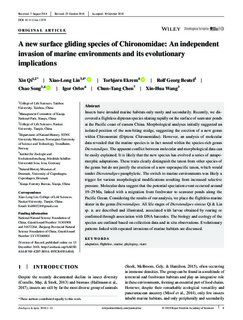| dc.contributor.author | Qi, Xin | |
| dc.contributor.author | Lin, Xiaolong | |
| dc.contributor.author | Ekrem, Torbjørn | |
| dc.contributor.author | Beutel, Rolf Georg | |
| dc.contributor.author | Song, Chao | |
| dc.contributor.author | Orlov, Igor | |
| dc.contributor.author | Chen, Chun-Tang | |
| dc.contributor.author | Wang, Xin-hua | |
| dc.date.accessioned | 2019-03-20T08:09:08Z | |
| dc.date.available | 2019-03-20T08:09:08Z | |
| dc.date.created | 2018-12-18T10:51:38Z | |
| dc.date.issued | 2018 | |
| dc.identifier.citation | Zoologica Scripta. 2018, . | nb_NO |
| dc.identifier.issn | 0300-3256 | |
| dc.identifier.uri | http://hdl.handle.net/11250/2590743 | |
| dc.description.abstract | Insects have invaded marine habitats only rarely and secondarily. Recently, we discovered a flightless dipteran species skating rapidly on the surface of seawater ponds at the Pacific coast of eastern China. Morphological analyses initially suggested an isolated position of the non‐biting midge, suggesting the erection of a new genus within Chironomini (Diptera: Chironomidae). However, an analysis of molecular data revealed that the marine species is in fact nested within the species‐rich genus Dicrotendipes. The apparent conflict between molecular and morphological data can be easily explained. It is likely that the new species has evolved a series of autapomorphic adaptations. These traits clearly distinguish the taxon from other species of the genus but do not justify the erection of a new supraspecific taxon, which would render Dicrotendipes paraphyletic. The switch to marine environments was likely a trigger for various morphological modifications resulting from increased selective pressure. Molecular data suggest that the potential speciation event occurred around 19–29 Ma, linked with a migration from freshwater to seawater ponds along the Pacific Ocean. Considering the results of our analysis, we place the flightless marine skater in the genus Dicrotendipes. All life stages of Dicrotendipes sinicus Qi & Lin sp. n. are described and illustrated, associated with larvae obtained by rearing or confirmed through association with DNA barcodes. The biology and ecology of the species are outlined based on collection data and in situ observations. Evolutionary patterns linked with repeated invasions of marine habitats are discussed. | nb_NO |
| dc.language.iso | eng | nb_NO |
| dc.publisher | Wiley | nb_NO |
| dc.relation.uri | https://onlinelibrary.wiley.com/doi/full/10.1111/zsc.12331 | |
| dc.title | A new surface gliding species of Chironomidae: An independent invasion of marine environments and its evolutionary implications | nb_NO |
| dc.type | Journal article | nb_NO |
| dc.type | Peer reviewed | nb_NO |
| dc.description.version | publishedVersion | nb_NO |
| dc.source.pagenumber | 12 | nb_NO |
| dc.source.journal | Zoologica Scripta | nb_NO |
| dc.identifier.doi | 10.1111/zsc.12331 | |
| dc.identifier.cristin | 1644718 | |
| dc.description.localcode | © 2018 Royal Swedish Academy of Sciences. Open access. | nb_NO |
| cristin.unitcode | 194,31,10,0 | |
| cristin.unitname | Institutt for naturhistorie | |
| cristin.ispublished | true | |
| cristin.fulltext | original | |
| cristin.qualitycode | 1 | |
